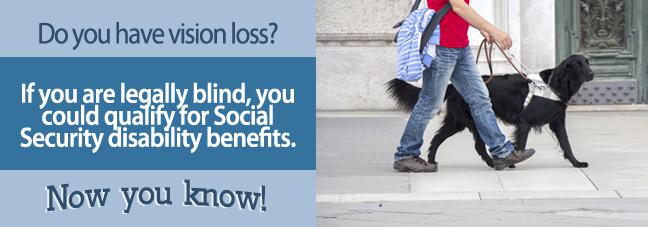The Social Security Administration (SSA) defines a functional limitation as a restriction or impairment of an individual’s ability to function in a manner that restricts them from taking part in a normal range of activities due to their vision loss. A functional limitation also relates to an individual’s ability to work in a job as well as handling the routine activities required for daily life.
The symptoms of vision loss may include:
- peripheral vision loss;
- night blindness;
- hazy vision;
- central vision loss;
- blurry vision.
Qualifying For Disability Benefits with a Functional Limitation
Because vision loss can affect your ability to see clearly it may not be safe for you to go to work as you may not only be a danger to yourself but to others your work with too. To qualify with for disability benefits with vision loss you are required to meet a Blue Book listing.
You will also need to provide your medical history which shows that you have been suffering from vision loss for more than 2 years or that you are expected to continue to suffer from vision loss for more than 2 years. Both eyes are evaluated for vision loss by the SSA and if you have 20/200 vision in your best eye you may be eligible for benefits.
If your vision loss does not meet a Blue Book listing, you might be able to qualify under a medical vocational allowance. In order to qualify for a medical vocational allowance, you will need to show that your vision loss has left you with functional limitations that prevent you from engaging in your usual work and any other work which would provide you with a living wage.
What to Expect When Applying For SSD with a Medical Vocational Allowance
If you decide to lodge an application for a medical vocational allowance the SSA will request you get your doctor to undertake a residual functional capacity test (RFC). This tests what you are capable of doing with your vision loss such as lifting a heavy object, standing in one place without the need to sit down and your ability to lift a heavy object, stand in one place without taking a rest and how much you can stretch and bend your torso.
The SSA will also review your medical history and decide whether your vision loss is likely to be permanent. It will also evaluate your capabilities to determine if there is any job you can do with your vision loss.

Next Steps to Take
When compiling your claim for disability benefits or a medical vocational allowance you must provide as much evidence as possible which proves your disability from vision loss prevents you from working. This includes your RFC test result and your present and past medical records. The SSA will then decide whether your disability is severe enough to qualify for disability benefits or a medical vocational allowance.
Talk to a Disability Attorney
Qualifying for social security disability benefits is not an easy process, but talking to a
disability attorney increases your chances of success. Complete a Free Case Evaluation on this page to get connected with an independent, participating attorney who subscribes to the website.